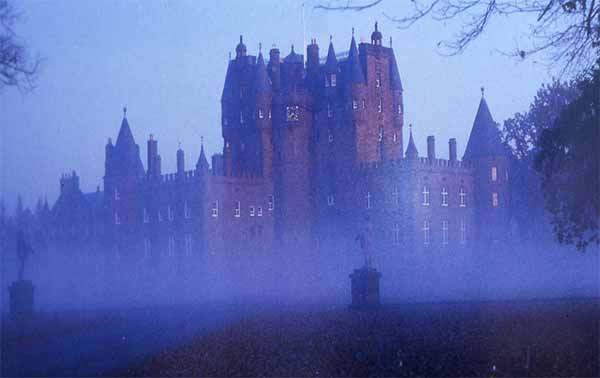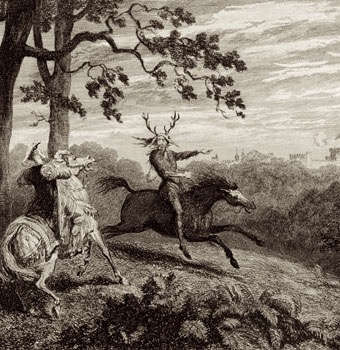Famous Scary Creepy Ghost Haunted English Castles

The figure of the ghost is found in all the cultural traditions of the world. British folklore has so completely integrated the ghost that the adjective “haunted” naturally comes to mind as soon as one speaks of a manor or a castle across the Channel.
Henry VIII's second wife haunts the Tower of London
Of course, the most famous of British fortresses, the Tower of London, has its share of famous appearances. Condemned to death for adultery, beheaded on May 19, 1536, by an executioner who came specially from France, Anne Boleyn was executed a thousand days after having married Henry VIII; she is the second of six wives - and the first victim - of the king. After the execution, her remains were hastily buried in Saint Peter's Chapel, at the Tower of London, where she was held prisoner. From then on, and for centuries - the last appearance dates back to 1933 - her wraith appears at regular intervals.
A headless ghost
One of the most impressive manifestations of the ghost occurred during the winter of 1864. One night, a sentinel was found unconscious. Accused of falling asleep at his post, the man appears before a military court. He tells that, around dawn, he saw a white silhouette emerge from the fog. A cap surmounted it, headless underneath, and she walked towards him. After making the three usual summons, the soldier approached the form; but, when the bayonet of his rifle passed through it, a lightning bolt spread along the barrel and he himself was knocked out by the shock. This would all seem like a well-found excuse if two other soldiers and an officer did not testify, after the accused's testimony, that they too had seen the specter through a window. When it turns out that the form, in all four cases, was seen just under the opening of the room in which Anne Boleyn had spent her last night before her execution, the court released the sentry.
The corpse of a cat
The long history of the Tour State prison, the quality of some of its detainees and the victims executed within its walls make the building a favorite field for ghosts. Great ladies of the kingdom, murdered there, would occupy the building, walking on the ramparts, along the corridors, crossing the walls. Margaret, Countess of Salisbury, for example, executed in 1541 at the age of 70 in excruciating conditions - the executioner had to do it three times to decapitate her - would periodically “relive” her last moments. But men also haunt the Tower. The oldest ghost is that of Saint Thomas Becket, assassinated in the midst of mass in Canterbury Cathedral in 1170, and who would sometimes return to visit the Tower of which he was once governor. Another illustrious specter is that of the great explorer Sir Walter Raleigh, imprisoned by James I for conspiracy from 1603 to 1616, released for two years, then locked up again, and beheaded. But two children, the young Prince Edward V and his brother the Duke of York, killed in 1483 by their uncle Richard III, would also walk in the corridors of the Tower, dressed in white dresses and holding hands.
Curiously, the keep of the fortress, the White Tower, seems to have never been haunted. Tradition has it that at the beginning of its construction, in the 11th century, there was practiced an animal sacrifice intended to ward off evil spirits. However, during work carried out in the 19th century, workers discovered inside one of the master walls the skeleton of a cat ...
What explanations for ghosts ?
For skeptics, the apparitions only have reality in the minds of those who see them. Modern parapsychologists share this point of view in many cases, but maintain that a minority of testimonies resist any attempt at rational explanation. Ghosts, according to them, appear “spontaneously” or their manifestation is “provoked” by a medium. For some, the specter is the manifestation of the spirit of a dead man; for others, it is the product of the spirit of the medium or of the witness who attends the appearance. The first explanation postulates the existence of an entity independent of the body (the soul?), capable of surviving death and becoming more or less visible at will. The second explanation only seems to join that of the skeptics; it supposes indeed that what the witnesses see has a tangible existence instead of revealing only psychic fantasy.
Haunted castles
Glamis Castle (Scotland)

This royal family home sees its corridors haunted by the specter of a young woman executed in the 16th century, Janet Douglas. But strange games of cards also take place there, between players who have died since the 15th century. Finally, a counterfeit son of the family, locked up between four walls during his lifetime, would still scream his pain, some nights.
Hampton Court Palace
This residence, where Henri VIII and his wives lived, is haunted by their appearances: Anne Boleyn; Catherine Howard, the king's fifth wife, beheaded for adultery in 1542; Jane Seymour, who died giving birth to her son. But other specters, those of the nurse of Edward VI, Queen Elizabeth I and King Henry III, would also haunt the castle.
Windsor Castle

The forests of this castle would be traversed by a ghost knight : the specter of a young man named Herne the Hunter, once a favorite of King Richard II, and who committed suicide after his disgrace. The last appearance of the ghost dates back to 1976, when the knight appeared from the night in front of a young man, who fell unconscious ...









































































































































































































































































































































